[ZX Spectrum, Dinamic Software]

Mapsnatch is, to my knowledge, the first Spanish computer strategy game. Unfortunately, this is not a grand entrance from Spain, as Mapsnatch is nothing more than a mini-Risk in Europe. Once the number of players (1-3) is chosen, the game distributes the 12 territories between them. Each region receives 4 armies (ejercitos) and each player also receives a reserve: 22 armies for me (SCRibe), 26 for the computer (SPEctrum).
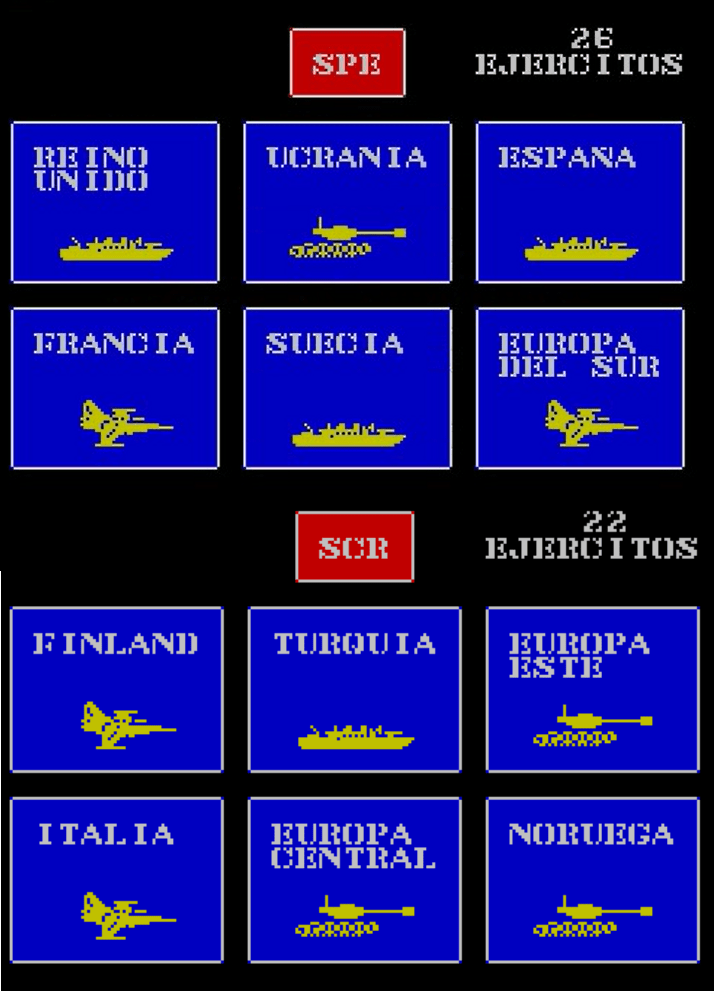
The icon below the country (tank/ship/plane) is to my knowledge cosmetic.
Each player has one action by turn. Before I even have an opportunity to see the map, the computer attacks Norway from United Kingdom. Battles are resolved by throwing one die by army (max: 3 dice) and comparing the result. I lose one army in this first battle.

Then it is my turn, and I finally get to see the map. Unfortunately, it is not colour-coded, so I will not have the satisfaction of seeing the colour of my choice spread out and replace all the other colours.
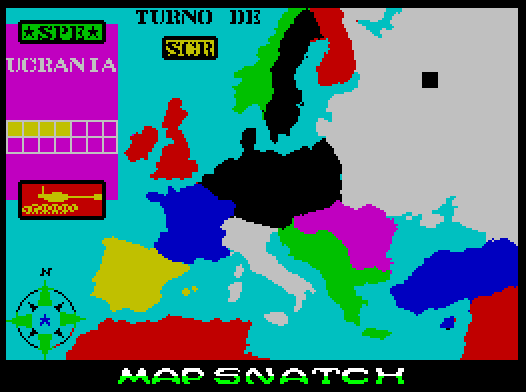
I have 3 possible actions:
- Attack,
- Move units from my reserve to a province,
- Move units from a province to the reserve,
Unsure about my next move, I reinforce Norway by pulling from the reserve.
The following turn, I discover something surprising: the “map” in Mapsnatch is just cosmetic. Any region can attack any other region, and the computer proves it by attacking Finland from Spain!
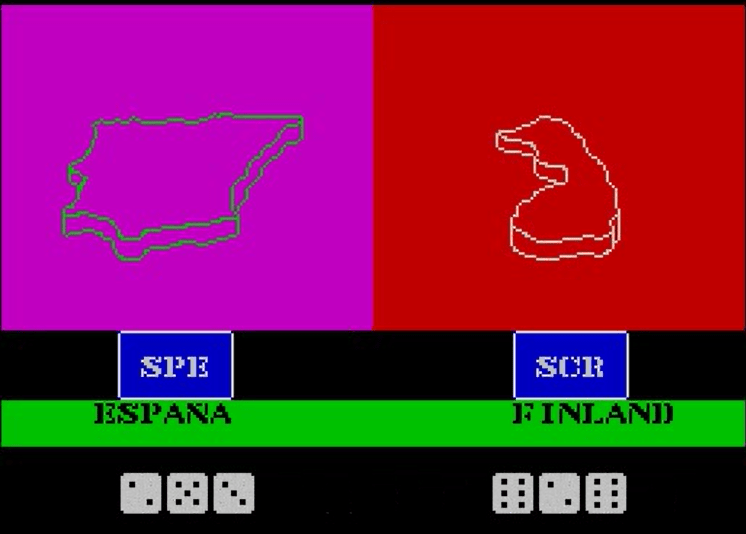
In this case, the computer is unlucky and loses all its forces! Spain immediately becomes mine… and 3 new armies spawn in Spain to occupy it!

Conquering a territory, either actively or because your opponent fumbled, is the only way to generate new armies. Unlike in Risk, you don’t earn armies by holding territory,
Given all territories are equal and that holding them does not give any advantage, I have no time pressure and I let the computer attack turn after turn. Sometimes, one side wins the battle decisively and wipes out the other while earning 3 armies. But more frequently, the result is just some losses for one side or the other. If I was the one losing some armies, I pull from my reserve and replace them during my turn. If, on the other hand, the computer loses some armies, I get to counter-attack before the computer can pull from its reserve and so I fight with a die advantage, easily winning the battle and earning 3 more armies!

I am the bank at a casino: I win some and I lose some, but statistically the rules are rigged in my favour. After maybe 20 or 30 battles, the computer launches its last attack from Finland, loses decisively, and lets me conquer the last chunk of Europe I was missing. I win!
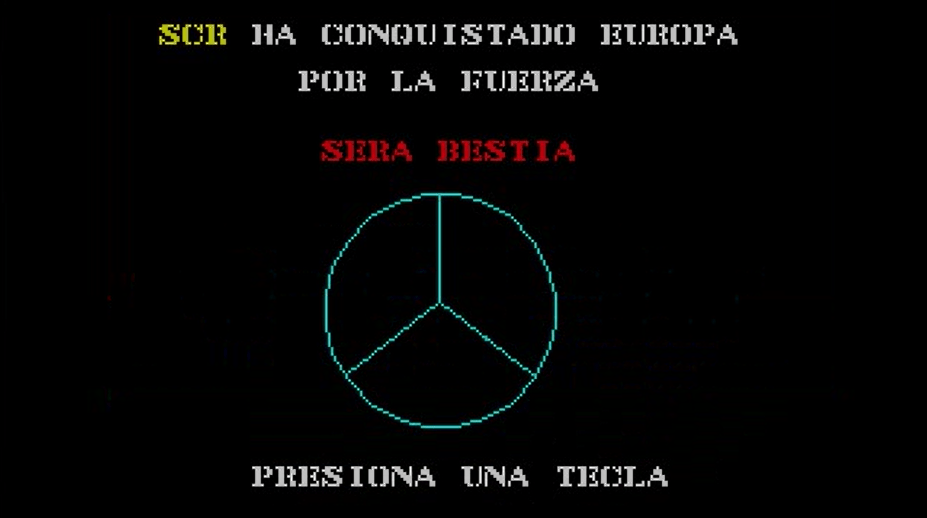
Ratings and Review

Mapsnatch by Ignacio “Snatcho” Ruiz Tejedor, published by Dinamic Software, Spain
First release: July 1984 on ZX Spectrum
Genre: Conquest
Average duration of a campaign : 20 minutes
Total time played: 20 minutes
Complexity: Trivial (0/5)
Rating: Totally obsolete
Ranking at the time of review: 146/153
Context – In 1980-1981, brothers Victor, Pablo and Nacho Ruiz Tejedor were doing the typical nerdy Spanish teenager things of their era: going to the console room, playing endless games of Risk with homebrew rules and finally tinkering stuff in the attic-turned-workshop of their parents’ house in Boadilla del Monte, near Madrid. Víctor particularly shined in the latter, having even conceived, while still in high school, an electro-mechanical game where the player had to move a car left and right to stay on a road drawn on a treadmill.
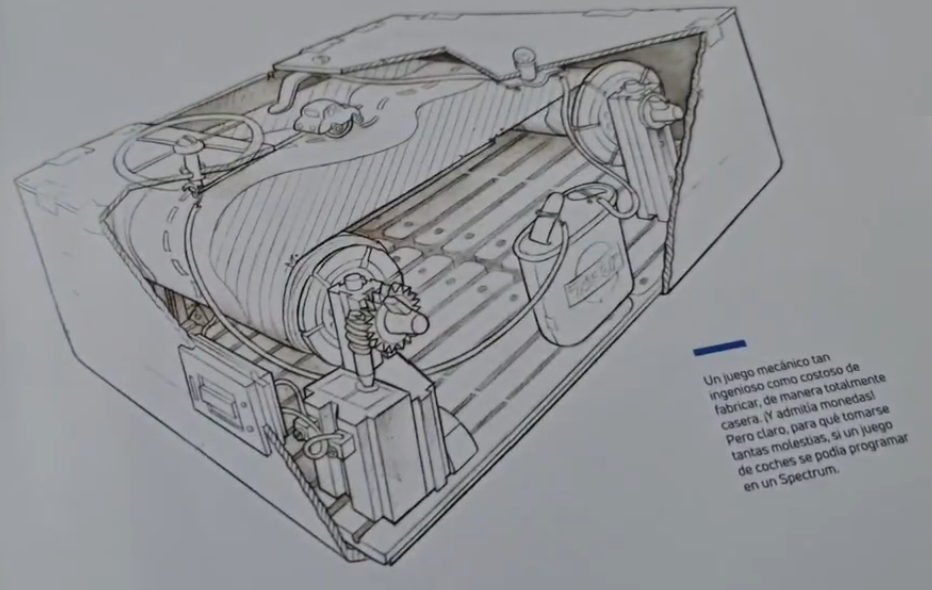
The game was great and the brothers remember spending hours on it, but short (it lasted around 30 seconds) and too easy despite attempts to make the road increasingly serpentine over time. In 1981, the course of their lives changed when their uncle living in London and presumably aware of their proclivities brought them a ZX81.
The brothers learned to program and ported their car game to their ZX81, adding features like oil on the road and a scoring system. However, they experienced first-hand the limitations of the ZX81, and soon their attention turned to the new Sinclair computer : the ZX Spectrum. Endlessly gawking over its specs, they knew they had to procure it and took upon themselves to collect the money, one way or another. While they never thought of selling their car game, which means that sadly it never left Boadilla del Monte, three teenagers willing to do any odd job and with no food or rent to pay can quickly generate a decent amount of cash, and soon they collected enough money to buy a ZX Spectrum 16k (£125). Their uncle respected their dedication and directly upgraded them to a 48k (£175).
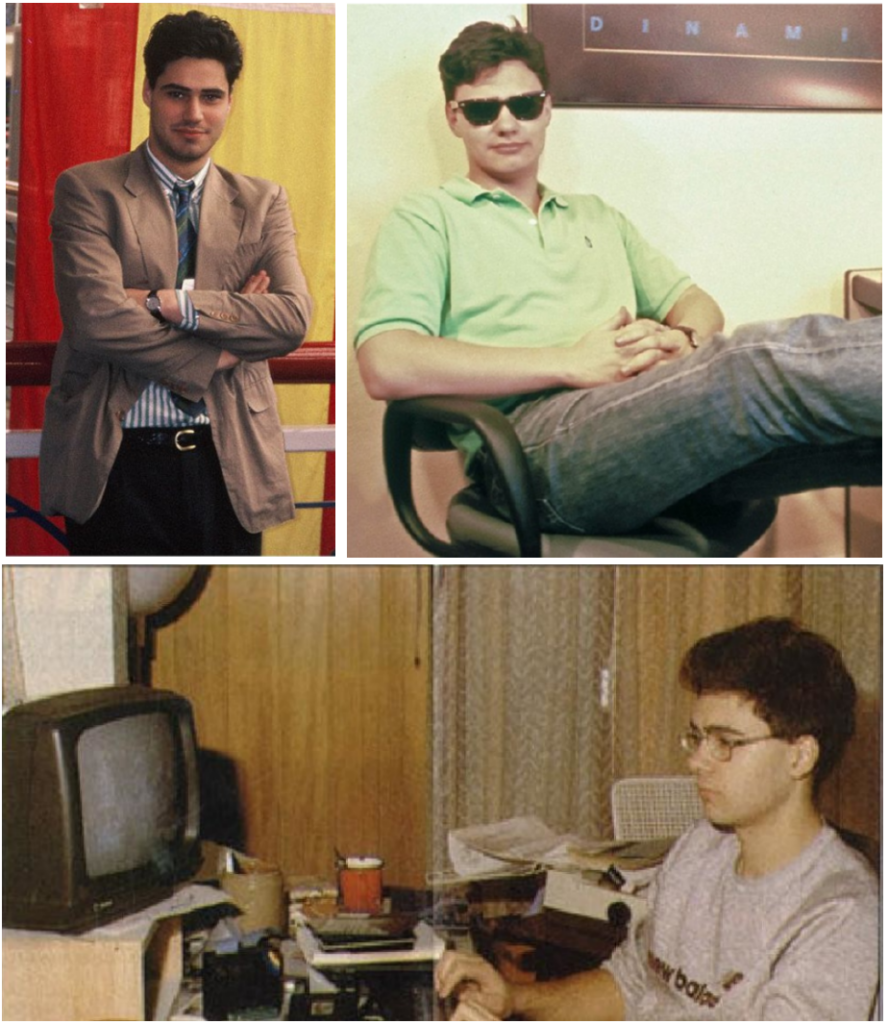
The brothers had huge plans for that Spectrum, and their strengths perfectly complemented one another. The older brother Víctor was by far the most technical and had learned to code at an amazing speed. He created graphical tools for the artistic youngest Nacho (aka Snatcho), tools he later compiled in a software called “Artist“. Finally, the middle brother Pablo was never credited as a programmer or designer, and possibly he never learned to code. He had on the other hand all the skills of a businessman. Together, they wrote an adventure game called Yenght (credited to Víctor and Snatcho only). Extremely happy with the result, they decided to create a company to sell it, and that’s how Dinamic Software was founded. As for the name “Dinamic”, the brothers wanted a meaningful one-word name like other video game companies they knew: Ultimate, Imagine and Ocean.
The best game in the world is nothing if people don’t know about it, and the brothers realized they had to advertise it somewhere. They earmarked the Spanish magazine ZX, but realized it would cost 40 000 pesetas [close to €2000 contemporary euros]. As the Ruiz brothers tell the story, a local writing competition had by coincidence a prize of 40 000 pesetas and the brothers, who really had all the talents, submitted a collective creation called ¿Dónde están los dragones?, which won the prize. The financial obstacle removed, the ad could be published in the May 1984 issue of ZX.

Nothing happened for a while; for more than one week after the release of the ZX issue, the brothers did not receive anything. And then, on the 8th of May, they received 8 orders. The 9th: tens of orders. By the 14th, there were so many that the postman could not fit them in the letterbox, and had to hand them a bag. This was more than they expected, and there was the delicate problem of actually filling the orders: the Ruiz had only one tape recorder and duplication took 7 minutes by tape. Said otherwise, the three brothers could theoretically process 200 orders a day, and much fewer in reality as Nacho was still in high school and the other brothers studying – a night rotation had to be established, a process that also included a verification phase on the Spectrum.

As they were facing hundreds of orders, the brothers realized their operation would be mightily profitable, and they moved to the next games, with Nacho focusing on the strategy game Mapsnatch while Victor worked on the exploration game Saimazoom. Meanwhile, Pablo processed the orders, replication aside: printing the manual, packaging them with the tapes, sending them and of course the hardest task of them all: managing taxes for an activity that did not exist according to the tax code.
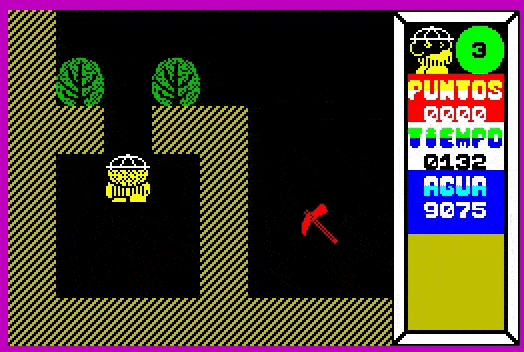
It’s not a wargame, but I can’t resist talking a bit more about Saimazoom, whose history showcased the nascent marketing skill of Pablo. Saimazoom is inspired, as it happens, by ads for the coffee brand Saimaza. The typical Saimaza ad of the 1980 featured an adventurer overcoming obstacles in his travels to the most remote parts of South America to find coffee authentic enough for Spanish palates. Similarly, Saimazoom had the main character look for 4 bags of coffee beans in a huge 10×10 map, though the natives were a lot more hostile.
Saimazoom was visually and technically top-tier for 1984, and quite fun to play too, so the Ruiz brothers knew they had a future hit on their hands. Instead of relying exclusively on traditional advertisement, Pablo contacted the video game magazine MicroHobby and asked whether Saimazoom could be on the cover, offering in exchange to provide a full map of the game which would justify the cover. “Exclusive content” is hard to pass for a magazine, particularly when it is at no cost and no effort. MicroHobby had its cover for the week, Dinamic had a better advertising space than money alone could buy, and Saimazoom was a huge success.
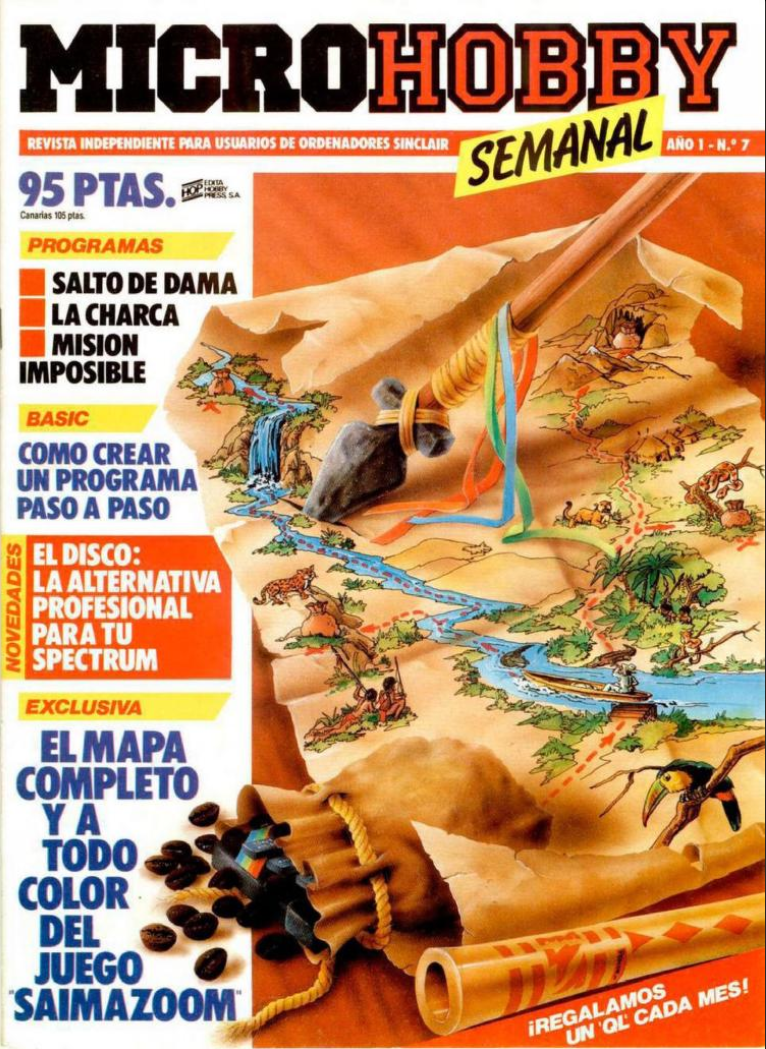
As for Mapsnatch, the first Spanish strategy game, there is very little to say. It is a footnote in the history of Dinamic and Nacho does not remember much about a game he developed when he was in high school. In La Historia de Dinamic, he states he chose to port Risk because he knew he did not have the coding skill for action games. However, leaning on his skill set, he tried to make up for the lack of depth with great visuals, but it did not save the project. Mapsnatch was barely mentioned in contemporary magazines, and the brothers themselves did not advertise it; its only review by MicroHobby (issue #3) is positive but restrained, “for young people to familiarize themselves with wargames“.
Traits – Without any geography (except cosmetic), no reason to take a territory rather than another, no time pressure and a defensive advantage, Mapsnatch is just about being more patient than the opponent. In solitaire, the computer has the good taste of attacking so the player will (statistically) win, in multiplayer between adults, games probably never end as both sides wait for the other to attack.
Did I make interesting decisions? None
Final rating: Totally obsolete. As far as Risk-like games are concerned, its gameplay is even worse than Shards Software’s Empire, though I rank it marginally above as a game because at least it’s pretty and the controls are intuitive.
Aftermath
Dinamic Software continued for years, but specialized in action games and to my knowledge never returned to strategy games, so that was a long article for one minor game. However, I find it interesting to talk about specifically the aftermath of Saimazoom. The game was, as I said, very successful and Dinamic released a spiritual sequel in December 1984: Babaliba. Babaliba also being successful in Spain, Dinamic moved to the next logical step of the typical Spanish developer and tried to penetrate the British market. For this, Pablo contacted Silversoft, a British company with huge ambitions after the success of their game Worse Things Happen at Sea, to publish Saimazoom and Babaliba. Alas, Pablo this time chose poorly: Silversoft was a one-hit-wonder which did not know how to publish games and quickly went under, and Dinamic never received its royalties for Saimazoom and Babaliba. It was not all for naught however: Pablo had traveled to UK on Silversoft’s dime and had brought back to his third and youngest brothers, the then-15-years-old Gaby, a football game for the Spectrum. This was a revelation for Gaby who soon turned his passion for football into a career, but would also join his older brothers to design what would become in the 90s the flagship license of Dinamic: PC Fútball.
Sources
- Ocho Quilates, una historia de la edad de oro del Software español, Jaume Esteve Gutiérrez. I find the book full of obvious mistakes, but the part on Dinamic is simply a huge interview of the Ruiz brothers.
- La Historia de Dinamic, Jesús Martinez del Vaz. It covers every single one of their games.
- Asi fue como Dinamic la mitica compania de videojuegos
- Pablo Ruiz – historia del videoguego espanol de dinamic a fx interactive
- Manuel Moreno levando los videoguegos al parlamento europea con una historia de romanos. Manuel Morena was a neighbour of the Ruiz brothers who confirms among others the “postman-with-a-bag-of-mail-orders” story.
5 Comments
Fascinating. Whenever I was loading a game up in the UK and I spotted Dinamic on the loading screen, my heart would sink. Nothing wrong with the quality, but the games were notoriously hard. Abu Simbel Profanation and Army Moves are famously impossible. Odd to think that the first game allowed you to win simply by playing. They must have made up with that error ever since.
A birthday treat for me! Army Moves really was impossible.
Mapsnatch made me smile as “Snatch” is a slang word for a lady’s private parts. It’s nicely drawn, and the graphics are neat… but lacking in depth. I was thinking that the Tank/Plane/Ship symbols would be the equivalent of the Infantry/Cavalry/artillery symbols of Risk, which has a similar pro-Ukraine viewpoint!
That Saimazoom is my kind of game. Pith helmets!
“Snatch” is a slang word for a lady’s private parts.
=> !! I had no idea. To think I needed to read a wargaming blog to finally understand why the quiz section in each episode of RuPaul’s Drag Race was called The Snatch Game. (facepalm!)
This also makes the nickname “Snatcho” 120% more funny.
Thanks for the great article, Scribe!
> the flagship license of Dinamic: PC Fútball.
Never heard about their other games, but PC Fútbal 7 was a big hit in Italy in the late nineties. Tips and tricks about the game made a very popular conversation topic for a couple of years at my high school. The cheap tag price – the equivalent of less than 10 Euros in a world where 50 was the norm – made the game extremely popular among teenagers and discouraged piracy.
> Mapsnatch is bullish on the Ukrainian conflict.
I was about to comment something about Germany not having the honour of appearing as single nation, but for a Spanish game I think the biggest diplomatic insult must be the disappearance of Portugal, apparently annexed by the House of Borbón.
Another wonderful article from Wargaming Scribe about Spanish software from the 80s, in this case about Mapsnatch and the beginnings of Dinamic. The sources are excellent and thus the quality of everything described is unbeatable. Thanks a lot!